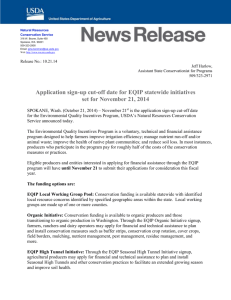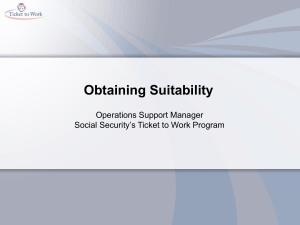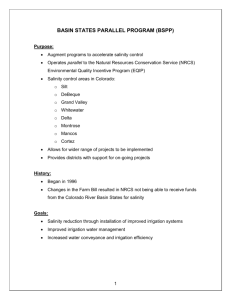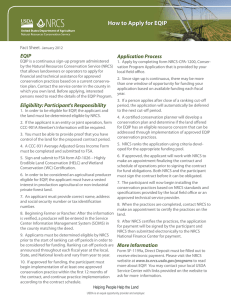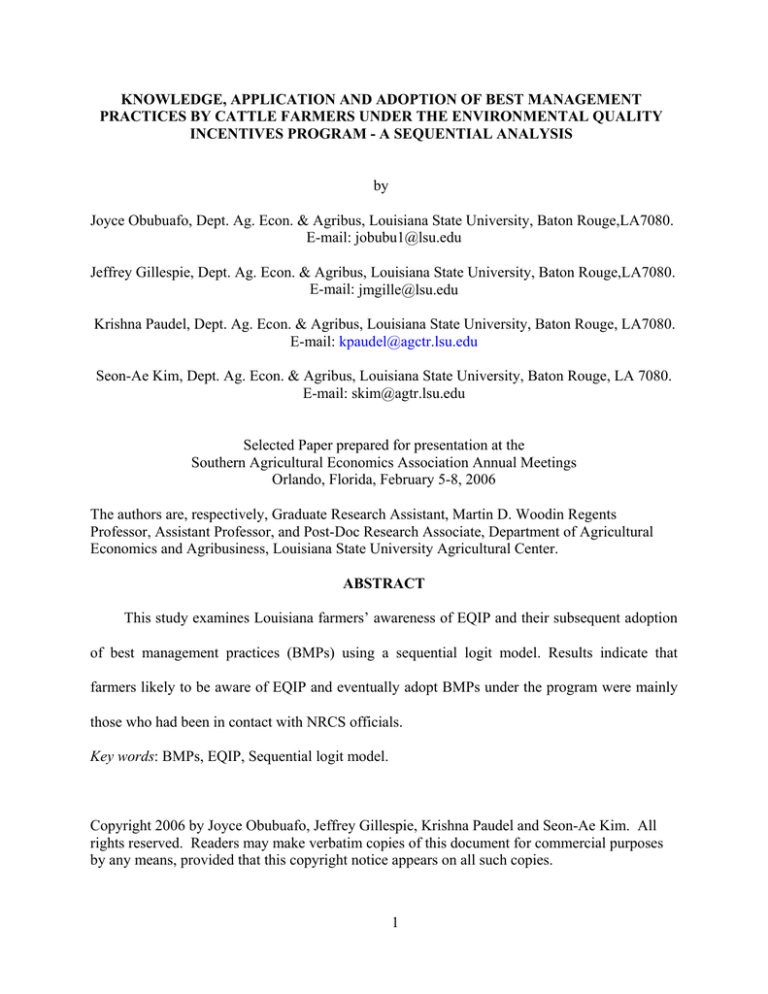
KNOWLEDGE, APPLICATION AND ADOPTION OF BEST MANAGEMENT
PRACTICES BY CATTLE FARMERS UNDER THE ENVIRONMENTAL QUALITY
INCENTIVES PROGRAM - A SEQUENTIAL ANALYSIS
by
Joyce Obubuafo, Dept. Ag. Econ. & Agribus, Louisiana State University, Baton Rouge,LA7080.
E-mail: jobubu1@lsu.edu
Jeffrey Gillespie, Dept. Ag. Econ. & Agribus, Louisiana State University, Baton Rouge,LA7080.
E-mail: jmgille@lsu.edu
Krishna Paudel, Dept. Ag. Econ. & Agribus, Louisiana State University, Baton Rouge, LA7080.
E-mail: kpaudel@agctr.lsu.edu
Seon-Ae Kim, Dept. Ag. Econ. & Agribus, Louisiana State University, Baton Rouge, LA 7080.
E-mail: skim@agtr.lsu.edu
Selected Paper prepared for presentation at the
Southern Agricultural Economics Association Annual Meetings
Orlando, Florida, February 5-8, 2006
The authors are, respectively, Graduate Research Assistant, Martin D. Woodin Regents
Professor, Assistant Professor, and Post-Doc Research Associate, Department of Agricultural
Economics and Agribusiness, Louisiana State University Agricultural Center.
ABSTRACT
This study examines Louisiana farmers’ awareness of EQIP and their subsequent adoption
of best management practices (BMPs) using a sequential logit model. Results indicate that
farmers likely to be aware of EQIP and eventually adopt BMPs under the program were mainly
those who had been in contact with NRCS officials.
Key words: BMPs, EQIP, Sequential logit model.
Copyright 2006 by Joyce Obubuafo, Jeffrey Gillespie, Krishna Paudel and Seon-Ae Kim. All
rights reserved. Readers may make verbatim copies of this document for commercial purposes
by any means, provided that this copyright notice appears on all such copies.
1
INTRODUCTION
Louisiana accounts for about 1.7% of the total US cattle operations. Producers are
encouraged to reduce stream water pollution that results from animal waste, application of
agrochemicals and other farming activities by using best management practices (BMPs). Some
programs have been implemented to encourage the use of BMPs such as the Environmental
Quality Incentives Program (EQIP).
This program involves the payment of subsidies to
landowners willing to implement specific cost-intensive conservation practices (Vigil et al.). The
EQIP works together with other federal programs and is the only program that explicitly targets
funds to address livestock production environmental concerns. Nationally, at least 50% of EQIP
funds must be used for natural resource concerns related to livestock (Vigil et al.). The question
is whether farmers are aware of the existence of the EQIP and, if so, whether they are
implementing BMPs using EQIP funds.
Most previous studies involving environmental problems related to agricultural production
have focused on factors affecting the adoption of BMPs (e.g. Antle and Diagana; Brannan et al.;
Inamdar et al.; Rahelizatovo and Gillespie; Kim et al.) and the awareness of incentive programs
(e.g. Feather and Amacher; Ipe et al.; Cooper). Current use of the EQIP to aid farmers in BMP
adoption has been described as “modest to meager” (Brewer et al.). This problem may be due to
a lack of information about EQIP and the benefits derived from adopting BMPs (Feather and
Amacher; Ipe et al.; Cooper; DeVuvst and Ipe); or social isolation (Wilkening).
Some studies have shown that BMP helps to reduce pollution, often at little cost to the
farmer, and is more intensive if public supported financial incentives are offered to farmers
through programs like EQIP (Taylor et al.). Personnel involved in the administration of the
EQIP, the USDA Natural Resource Conservation Service (NRCS), are in contact with farmers
2
and thus play an important role in educating farmers on BMPs. Farmers’ perceptions are changed
in the educational process, increasing their knowledge of BMPs and of the conservation
program.
The objectives of this study are to: (1) determine the proportions of cattle producers in
Louisiana who: (a) have no knowledge of EQIP; (b) have knowledge of EQIP but have not
applied to the program; (c) have knowledge of EQIP, have applied, but have not been accepted
for funding; (d) have knowledge of EQIP, have applied, have been accepted, and did not cancel
the program later and (e) have knowledge of EQIP, have applied to the program, have been
accepted but canceled the program later; and (2) determine the types of producers who fall into
each of these categories.
THE MODEL
The Sequential Logit Model:
The sequential logit model is a discrete choice model. Up to the early 60’s, there was no
recognized field of statistical theory known as sequential analysis (Johnson). However, a variety
of ad hoc sequential sampling methods were constructed in response to many specific problems.
The sequential probability ratio test, s.p.r.t, which is based on the likelihood ratio, gave rise to
sequential analysis. Recent sequential procedures have been introduced for comparative clinical
trials (Whitehead). Other works using sequential analysis have examined sequential designs in
nonlinear problems (Hu), the bias of maximum likelihood estimation following a sequential test
(Whitehead), group sequential distribution-free methods for the analysis of multivariate
observations (Su and Lachin), and simple methods for constructing exact tests for sequentially
designed experiments (Andrews and Herzberg). A limitation associated with the sequential logit
model is that, in some cases, the sequentially conducted process affects the probability
3
distribution, thus increasing the variance substantially (Whitehead). The number of observations,
N, required for an unbiased estimation depends on the explanatory variables, m and the expected
pseudo R2:
N > [8(1-R2) / R2] + (m-1).
Sequential analysis splits continuous variables into more alternatives that can increase m.
The potential gain from sequential analysis can, however, outweigh the losses (Andrews
and Herzberg). The sequential logit analysis of this study involves five levels. Each level (except
for the first) depends on previous results. Binary logit models are run, where the first level is
estimated from the entire sample, then subsequent ones from the sub-sample of the preceding
level after eliminating “no” observations. The sequential response probability is then obtained
using the results obtained from the series of binary logit model runs. The cumulative distribution
function for a logistic distribution is given as:
(1) P(yz=1 │ x’t) = ( F β , x ) =
z
1
(1+ exp( β , x
,when yz = 1
z
))
And
(2) P(yz=0 │ x’t) = (1 - F β , x ) =
z
exp( β , x )
z
(1+ exp( β , x
z
, when yz =0
))
where F(β’xz) is the cumulative distribution function with respect to β’xz (Hill et al.). Thus, the
actual probability estimates for the sequential response model, Pz, where z= 0, 1, 2, 3, 4, can be
represented as follows:
(3) P0= [1-F (β’x1) = exp( β ' x1 )
1+ exp( β ' x1 )
4
(4) P1= F (β’x1)[1- F (β’x2)] =
exp( β ' x 2 )
1
*
1 + exp( β ' x 2 )
1 + exp( β ' x 1 )
(5) P2= F (β’x1) F (β’x2) [1- F (β’x3)] =
exp( β ' x 3 )
1
1
*
*
1+ exp( β ' x 1 )
1+ exp( β ' x 2 )
1+ exp( β ' x 3 )
(6) P3= F (β’x1) F (β’x2) F (β’x3) [1- F (β’x4)]
=
exp(β' x 4 )
1
1
1
*
*
*
1+exp(β' x1)
1+exp(β' x 2 )
1+exp(β' x 3 )
1+exp(β' x 4 )
(7) P4= F (β’x1) F (β’x2) F (β’x3) F (β’x4)
=
1
1
1
1
*
*
*
1+ exp(β' x 4 )
1+ exp(β' x 3 )
1+ exp(β' x 2 )
1+ exp(β' x1 )
Marginal Effects: To determine the effects of one-unit changes in each of the explanatory
variables on the dependent variable, the marginal effects are derived from the probabilities
obtained for the sequential logit model. Determining the marginal effect of a dummy variable is
different from that of a continuous variable. Let a particular dummy variable at a level, z, be
represented by Xz for a binary operation where Xz can take only values 0 and 1. To obtain the
marginal effect of Xz at each level z, the actual values of Xz (0 and 1) are plugged into the
probability equations (3) to (7) instead of the means and the difference in the resultant values are
the marginal effects. For other dummy variables in the models, if their means are less than 0.5,
the value 0 replaces the mean. For means greater than or equal to 0.5, the value 1 replaces it. For
continuous variables, means are used. Both probabilities are obtained for yz when xz=1 and when
xz=0 and the difference between the probabilities gives the marginal effect, ∆Pz (Greene, 2000):
(9) ∆Pz= P [yz│ xt=1]-P [yz│xt =0]
The marginal effects for continuous variables are obtained by taking derivatives of the
predicted probabilities for the individual variables (Maddala):
Let PZ= f(yz), then
5
(10)
∂Pz
= ∂f ( y z )
∂x z
Data and Description of Variables
In Summer, 2003, 1,500 Louisiana cattle producers were surveyed to determine their knowledge
and use of EQIP, as well as adoption of BMPs. An initial questionnaire was sent to the
producers, followed by a postcard reminder two weeks later, and followed by a second
questionnaire two weeks after the postcard. Those mailed surveys included farmers with less
than 20 animals (26.5%), 20-49 animals (23.5%), 50-99 animals (23.5%), and 100 or more
animals (26.5%). Of the surveys sent, 504 were returned completed while 270 were returned
incomplete. The adjusted return rate was 41%.
The dependent variables are represented as follows, where EQIPz represents the dependent
variable Yz at the level z as indicated in equation (1). EQIP0 represents the level where
individuals have no knowledge of EQIP. EQIP1 represents the level where individuals have
knowledge of EQIP but have not applied to the program. EQIP2 represents the level where
individuals have knowledge of EQIP, have applied to the program, but have not received any
form of payment. EQIP3 represents the level where individuals have knowledge of EQIP, have
applied to the program, have received some form of payment, and have not cancelled the
contract. Finally, EQIP4 represents the level where individuals have knowledge of EQIP, have
applied to the program, have received some form of payment, but cancelled the contract later.
For the logit analyses from which the EQIPz marginal effects are calculated, the dependent
variables used are as follows: KNEQIP represents whether the farmer has knowledge of EQIP.
APEQIP represents whether the farmer applied for EQIP funds. PEQIP represents whether the
farmer received payment under EQIP. CNEQIP represents whether the farmer canceled EQIP.
6
Table 1 shows the units and definitions of the explanatory variables and Table 2 gives the
expected signs for the logit and sequential models. Expected signs for the variables in the
sequential models (Table 2) can be derived using reasoning based on the expected signs of the
variables for the logit models. A summary of the descriptive statistics of the explanatory
variables for the entire sample of cattle producers completing the questionnaire is given in Table
3. Thus, (1) EQIP0= KNEQIP=0. It is expected that the variables in the model EQIP0 would have
signs opposite of those in the KNEQIP model, (2) EQIP1= (KNEQIP=1) (APEQIP=0). It is
expected that the variables in the model, EQIP1 would be opposite of those in the APEQIP
model, (3) EQIP2= (KNEQIP=1) (APEQIP=1) (PEQIP=0). It is expected that variables in the
model EQIP2 would be opposite of those in the PEQIP model, (4) EQIP3= (KNEQIP=1)
(APEQIP=1) (PEQIP=1) (CNEQIP=0). It is expected that the variables in the EQIP3 would be
opposite in sign to those in the CNEQIP model, and (5) EQIP4= (KNEQIP=1) (APEQIP=1)
(PEQIP=1) (CNEQIP=1). It is expected that the variables in EQIP3 would have the same signs as
those of the CNEQIP model.
Additional tests carried out in this study were for heteroskedasticity using the Park test,
(Hill et al.); and the correlation coefficient, variance inflation factors and the Collins test to
determine whether multicollinearity existed (Kennedy).
RESULTS AND DISCUSION
Using the Park test, results obtained for the model KNEQIP showed P-values greater than
0.10, indicating that heteroskedasticity was not detected at either the 5% or 10% levels. The
same outcome is, thus, expected for the remaining models. Multicollinearity was not found to be
problematic using correlation coefficients and the variance inflation factors. However, using the
Collins test, the values for one variable, MALE, in each equation, was greater than 20. However,
7
Belsky et al. suggested that condition indexes (CI) of greater than 100 are the greatest threat to
variance inflation and, thus, to regression estimates. Since these CI values were less than 100 and
all variables were believed to be important for the economic analysis, they were left in the model
and analyzed.
Non-Sequential Model Results (Logit)
Results indicate that 49% of the cattle farmers in Louisiana had no knowledge of EQIP
while 51% of them had knowledge of EQIP. The percentage correctly predicted for KNEQIP
was 64.5%. Of the 228 farmers who had knowledge of EQIP, 43% had not applied to EQIP and
55% had applied to the program. The percentage correctly predicted for APEQIP was 64.30%.
Results indicate that of the 224 farmers who applied to the EQIP, 32% of them did not receive
EQIP funds, while 68% did. Percentage correctly predicted for PEQIP was 71.7%, in spite of the
general lack of significance of explanatory variables. Of the 138 farmers who received EQIP
funding, 82% did not cancel the program and 9% cancelled EQIP after being accepted to the
program. The pseudo R-square values indicate the model fits. The binary logit models had
relatively low pseudo R-squared values, which is rather common for logistic regressions
(Onianwa et al.). The pseudo R-squared values for the models, KNEQIP, APEQIP, PEQIP and
CNEQIP are 0.14, 0.12, 0.07, and 0.13, respectively.
Sequential Model Results
Tables 4 to 8 display the sequential model results.
Probability of Farmers Having No Knowledge of EQIP: Table 4 gives a description of the
parameter estimates for the sequential response model EQIP0 ≈ (KNEQIP=0). The results
indicate that the probability of a farmer not being aware of EQIP decreases for those farmers
who have had contact with NRCS and/or LCES officials at least four times in 2002, are
8
diversified, whose farms have been declared “highly erodible” by NRCS and for farmers who
operate beef cattle farms on larger tracts of land. All signs on significant variables were as
expected.
Probability of Farmers Having Knowledge of EQIP but Not Applying: Four of the
explanatory variables in the sequential model equation, EQIP1 ≈ (KNEQIP=1, APEQIP=0)
(Table 5), NRCS, HS, HELA, LCES and DIVERSE, were found to be significant at the 0.05 and
0.10 significant levels. This suggests that farmers who have had contact with NRCS and /or
LCES officials at least 4 times in 2002, are holders of a high school diploma and whose farms
have been declared “highly erodible” by NRCS and have knowledge of EQIP are more likely to
apply for EQIP funds. On the other hand, more diversified farmers having knowledge of EQIP
are less likely to apply to the program.
Probability of Farmers Having Knowledge of EQIP, Applying but Not Receiving EQIP
Funding: The results obtained for EQIP2 ≈ (KNEQIP=1, APEQIP=1, PEQIP=0) (Table 6),
showed one explanatory variable, NRCS, being significant at the 0.05 level of significance. This
suggests that applying farmers, who had contact with NRCS at least 4 times in the year 2002,
were more likely to receive EQIP funding.
Probability of Farmers Having Knowledge of EQIP, Applying, Receiving Payment and Not
Canceling EQIP
Table 7 gives the marginal effects for the independent variables for the sequential model
equation, EQIP3 ≈ (KNEQIP=1, APEQIP=1, PEQIP=1, CNEQIP=0). However, none of the
variables were found to be significant.
9
Probability of Farmers Having Knowledge of EQIP, Applying, Receiving Payment, but
Canceling EQIP: None of the explanatory variable was found to be significant for the sequential
model EQIP4 ≈ (KNEQIP=1, APEQIP=1, PEQIP=1, CNEQIP=1) (Table 8).
Results also indicate that, of the 504 cattle farmers who completed the survey
questionnaire, 48.1% of the farmers had no knowledge of EQIP, 29.8% had knowledge of EQIP
but did not apply to the program, 15.2% of farmers had knowledge of EQIP, applied to the
program but did not receive payment, 0.3% had knowledge of EQIP, applied, received payment
and did not cancel the program later, and 6.6% of them had knowledge of EQIP, applied to the
program, received payment and canceled the program later.
DISCUSSION
Educational programs for EQIP are conducted by NRCS via flyers, newsletters, public
meetings, public notices, word of mouth, etc. This targets all agricultural producer groups.
Based on the Louisiana ranking form used to determine whom receives EQIP funding,
farmers most likely to receive EQIP would include farmers whose lands: (1) are within the
drainage area of a water body that has been designated by the state water quality management
plan, (2) consist predominantly of soil with a surface layer K factor equal to or greater than 0.43
and (3) are within a parish listed as a significantly threatened and endangered species habitat.
Three additional factors include: (4) Planned treatment would assist the farmer in complying
with federal or state environmental laws, (5) the practice is environmentally beneficial, and
(6) the farmer has participated in a master farmer program. It was not surprising that, for the
sequential model EQIP1, farmers who had contact with NRCS and /or LCES officials at least 4
times in 2002, held high school diplomas, or whose farmlands had been declared “highly
erodible” had higher probabilities of applying to the EQIP program. That farmers holding high
10
school diplomas were more likely to apply to EQIP was also consistent with Katchova and
Miranda’s findings that educated farmers were more likely to enter into marketing contracts,
Cooper and Keim results which indicated that more educated farmers were more likely to adopt
water quality protection practices, and Ersado et al.’s findings that more educated farmers were
more likely to adopt productive and land enhancing technologies.
Selection of farmers for the EQIP program is based on the environmental benefits and cost
effectiveness of the BMP to be implemented. Results suggest that, farmers who have had contact
with NRCS officials and were, thus, likely to be more informed on whether and how to apply to
the EQIP had a higher probability of acceptance.
Other variables that were considered important in the study, RSTRM, AGE and LOWNED
were not found to be significant in any of the models. However, Cooper and Keim indicated that
farmers who owned greater portions of their land were less likely to adopt BMPs, while Ersado
et al. indicated otherwise. Ersado et al., Foltz and Chang, Katchova and Miranda; Kim et al., and
Rahelizatovo and Gillespie indicated that older farmers are more likely to adopt BMPs, while
Key and McBride indicated otherwise.
SUMMARY AND CONCLUSION
In this study, we modeled the awareness of the EQIP program by cattle farmers in
Louisiana and their subsequent adoption of BMPs under the program using data from a survey
carried out in 2003 by Kim et al. This survey involved 1,500 cattle producers in Louisiana to
determine their knowledge of EQIP and adoption of BMPs. A sequential logit model is used,
providing useful estimates which were consistent with other studies.
The results obtained indicate that, of the 504 cattle farmers who completed the survey,
48.1% of the farmers had no knowledge of EQIP, 29.8% had knowledge of EQIP but did not
11
apply to the program, 15.2% of farmers had knowledge of EQIP, applied to the program but did
not receive payment, 0.3% had knowledge of EQIP, applied to the program, received payment
and did not cancel the program later, and 6.6% of them had knowledge of EQIP, applied to the
program, received payment and canceled the program later.
Results indicate that farmers who had contact with NRCS and/or LCES officials at least
four times in 2002, diversified farmers, whose farms had been declared “highly erodible” by
NRCS, who had a greater portion of their household income coming from beef production, and
who operated larger sized cattle farms were more likely to be aware of the EQIP and apply to the
program. NRCS has been given the authority to administer the program; further funding of
education for NRCS would likely increase adoption rates. The Louisiana Cooperative Extension
Service also served as a source of information, but without the authority to administer EQIP, no
significant results were found beyond the knowledge of EQIP. In 2003, officials who administer
the EQIP informed producers of the conservation provisions of the 2002 Farm Bill. The result
was that ranchers and farmers applied for funding, resulting in significant backlogs in all
programs (Marcantel).
A significant number of farmers whose lands had been declared “highly erodible’ by
NRCS, according to the results obtained, had knowledge of EQIP, applied to the program and
adopted BMPs under EQIP. This buttresses the fact that, since NRCS has been authorized to
administer the EQIP, the more contacts they make with farmers significantly affects their
awareness of EQIP and their subsequent adoption of BMPs under EQIP.
Producers on cattle farms that had streams flowing through them were not found to be more
aware or to more likely eventual adopt BMPs under EQIP. Agricultural production has been
identified as a major cause of water pollution in the United States (Feinerman et al., Taylor et al.,
12
Kaplan et al., Peterson and Boisvert). The movement of byproducts from farming practices to
waterways, across fields, makes it difficult to identify the individual sources (Taylor et al.). In
order to reduce or eliminate agricultural run-off, farmers close to or miles away from streams
should be made aware of the EQIP and encouraged to adopt BMPs.
According to Fienerman et al., farmers who own large portions of their farmlands, run
larger cattle operations and receive larger percentages of their net household income from beef
production had more knowledge of BMPs and were more likely to adopt it. It would be
beneficial to the EQIP if these groups of farmers are kept in the program. They would serve as
informants and role models to new farmers (Taylor et al.).
From the results obtained, farmers who hold high school diplomas were more likely to
apply to the EQIP. This is not surprising, given past studies that have shown more highly
educated farmers to be the greater adopters of technology.
The sequential logit analysis happen to be the best model for this study because it does not
exhibit Individual irrelevance alternatives (IIA) and is an improvement on conditional analysis.
Further studies might involve carrying out similar analysis in other states in order to get a
better picture of how many cattle producers in the United States are aware of the EQIP and their
subsequent adoption of BMPs. Resources might be placed into developing soft wares that can
more readily conduct sequential logit analysis. The sequential analysis was calculated by hand
after obtaining the logit model results, making it tedious. It is hoped that a program would be
developed that can calculate sequential analysis problems more accurately, thus eliminating
errors and also saving time.
13
REFERENCES
1. Andrews, F. D. and Herzberg, M. A. “A Simple Method for constructing Exact Tests
for Sequentially Designed Experiments” Biometrika. Vol. 60(39) (1973): 469-497.
2. Antle, M.J. and B. Diagana. “Creating Incentives for the Adoption of Sustainable
Agricultural Practices in Developing Countries: The Role of Soil Carbon
Sequestration” American Journal of Agricultural Economics. Vol. 85(2003): 1178 –
84.
3. Berkson, J. “The Coefficient of Correlation” Science, New series. Vol. 77(1993): 259
4. Brannan, K. M., S. Mostaghimi, P. W. McClellan, S. Inamdar. “Animal Waste BMP
Impacts on Sediment and Nutrient Losses in Runoff from the Owl Run Watershed”.
Transactions of ASAE. Vol. 43(5) (2000): 1155-1166.
5. Brewer, M. J., L. E. Elworth, J.N Landis, and R. J. Hoard. “The Case and
Opportunity for Public-supported Financial Incentives to Implement Integrated Pest
Management”. Journal of Economic Entomology. Vol. 97(60) (2004): 1782-1789.
6. Cooper, C.J. and W.R. Kiem. “Incentive Payments to Encourage Farmer Adoption of
Water Quality Protection Practices.” American Journal of Agricultural Economics.
Vol. 78(1996): 54-64.
7. Cooper, J. C. “ A Joint Framework for Analysis of Agri-Environmental Payment
Programs” Prepared for presentation at the August, 2001, meeting of the American
Agricultural Economics Association, Chicago, Illinois: 1-29.
8. DeVuyst, E. A., and V. Ipe. “A Group Incentive Contract to Promote Adoption of
Best Management Practices”. Journal of Agricultural and Resource Economics. Vol.
24(2) (1999): 367-382.
9. Erado, L., Amacher, G. and Alwang, J. “Productivity and Land Enhancing
Technologies in Northern Ethiopia: Health, Public Investments and Sequential
Adoption.” American Journal of Agricultural Economics. Vol. 86(2) (2004): 321-331.
10. Feather, P. M., and G. S. Amacher. “Role of Information in the Adoption of Best
Management Practices for Water Quality Improvement”. Agricultural Economics.
Vol. 11(2-3) (1994):159-170.
11. Feinerman, E., Bosch, D.J. and Pease, J. W. “Manure Application and Nutrient
Standards”. American Journal of Agricultural Economics. Vol. 86(1) (2004): 14 – 25.
12. Foltz, J.D. and H. Chang. “The Adoption and Profitability of rbST on Connecticut
Dairy Farms”. American Journal of Agricultural Economics. Vol. 84 (4) (2002): 1021
– 32.
13. Greene, W.H. “Econometric Analysis” MacMillan Publishing Company, New York,
New York, 2000.
14. Greene, W.H. “LIMDEP Version 7.0 User’s Manual”. Econometric Software, Inc.
New York, New York, 1995.
15. Hatcher, H. “Dairying in the South” Economic Geography. vol. 20(1) (1944): 54-64.
16. Hill, R. C., W. E. Griffiths, and G. G. Judge. “Undergraduate Econometrics”. Second
Edition. John Wiley and Sons, Inc., New York, 2003.
14
17. Hu, I. “On Sequential Designs in Nonlinear Problems” Biometrika. Vol. 85(2)
(1998): 496-503.
18. Hu, J., K. Lahiri, R. Denton, Vaughan, and B. Wixon. “A Structural Model of social
Security’s Disability Determination Process”. Social Security Administration. An
abridged version of a working paper (1997).
19. Inamdar, S. P., S. Mostaghimi, M. N. Cook, K. M. Brannan, and P. W. McClellan. “A
Long-Term Watershed –Scale, Evaluation of the Impacts of Animal Waste BMPs on
Indicator Bacteria Concentrations”. Journal of the American Water Resources
Association. Vol. 38 (3) (2002): 819-833.
20. Ipe, V. C. and E. A. DeVuyst. “Group Incentive Programs for Farmer Adoption of
BMPs: An Application to the Nitrate Pollution Problem in Central Illinois”. Prepared
for American Agricultural Economics Association Annual Meeting, Augest 1999,
Nashville, Tennessee.
21. Johnson, L. N. “Sequential Analysis: Survey” Journal of Royal Statistical Society.
Series A (General). Vol. 124, No. 3(1961): 372-411.
22. Kaplan, D. J., C. R. Johansson, and M. Peters. “The Manure Hits the Land: Economic
and Environmental Implications when Land Application of Nutrients is Constrained”
American Journal of Agricultural Economics. Vol. 86 (3) (2004): 688-700.
23. Katchova, L A. and J. M. Miranda. “Two step econometric Estimation of Farm
Characteristics Affecting Marketing Contract Decisions” American journal of
Agricultural Economics. Vol. 86(1) (2004):88-102.
24. Kennedy, P. A Guide to Econometrics 3rd Edition. The MIT Press, Cambridge, 1992.
25. Kevin, T., McNamara, and W. Christoph. “Farm Household Income and On- and OffFarm Diversification”. Journal of Agricultural and Applied Economics. Vol. 37(1)
(2005): 37-48.
26. Key, N. and McBride. “Production Contracts and Productivity in the U.S. Hog
Sector”. American Journal of Agricultural Economics 85(1) (2003): 121-133.
27. Kim, S., J. M. Gillespie, and K. R. Paudel. “The Effect of Socioeconomic Factors on
the Adoption of Best Management Practices in Beef Cattle Production”. Journal of
Soil and Water Conservation. Vol. 60 (3) (2005): 111-120.
28. Maddala, G. S. “Limited-Dependent and Qualitative Variables in Econometrics”
Cambridge University Press. New York, 1983.
29. Mittelhammer,R. C., D. L. Young, D. Tasanasanta, and J. T. Donnelly. “Mitigating
the effects of Multicollinearity Using Exact and Stochastic restrictions: The Case of
an Aggregate Agricultural Production Function in Thailand”. American Journal of
Agricultural Economics. (2001): 201-205.
30. Onianwa, O., G. Wheelock, B. Gyawali. “Factors Affecting Participation Behavior of
Limited resource Farmers in Cost-Share Programs in Alabama”. Paper prepared for
presentation at the American Agricultural Economics Association Annual Meeting,
Montreal, Canada, July 27-30, 2003.
31. Rahelizatovo, N.C. and J.M. Gillespie. “The Adoption of Best-Management
Practices by Louisiana Dairy Producers.” Journal of Agricultural and Applied
Economics. 36(1) (2004): 229-40.
32. Ramanathan, R. “Introductory Econometrics with Applications” New York: Harcourt
Brace Jovanovich College Publishers, 3rd Edition, 1995.
15
33. Resource Person: Landreneau, T., Natural Resource Conservation Service, EQIP.
State Program Specialist, Louisiana.www.nrcs.org.
34. Riddle, D. F. “Calculus and Analytic geometry” third Edition. Wadsworth publication
Company Inc. Belmont, California, 1970.
35. Roberts, J.M. and N. Key. ”Who Benefits from Government Farm Payments?”
Choices, Third Edition (2003): 7-11.
36. Sun, H. L., J. Houston, J. Bergstrom. “Economic Analysis of Best Management
Practices in the Gum Creek Watershed Water Quality Program” Journal of Soil and
Water Conservation. Vol. 51(2) (1996): 176-180.
37. Su, Q. J. and Lachin, M. J. “Group Sequential Distribution-Free Methods for the
Analysis of Multivariate Observations” Biometrica. Vol. 48, No. 4(1992): 1033-1042.
38. Tan, S. T. “Calculus for the Managerial, Life, and Social Sciences”. Fourth Edition.
Brooks/Cole Publishing Company. An international Thomson Publishing Company,
1997
39. Taylor, M. A., Sohngen, B., Randall, A. and Pushkarskaya, H. “Group contracts for
Voluntary Nonpoint Source Pollution reductions; Evidence from Experimental
Auctions”. American Journal of Agricultural Economics. Vol. 86 (5) (2004): 11961202.
40. Vigil, N., J. Allen, B. Creighton, H. Fuchs, D. Thomas and K. Walker. “Natural
Resource Reporter”. Published by the New Mexico Natural Resources Conservation
Services, U.S. Department of Agriculture, 2003.
41. Whitehead, J. “On the Bias of Maximum Likelihood Estimation Following a
Sequential Test”. Biometrika. Vol. 73, No. 3 (1986), 573-581.
42. Wilkening, E. A. “Social Isolation and Response of Farmers to Agricultural
Programs”. American Sociological Review. Vol. 16, No. 6 (1951), 836-837.
43. Wooldridge, J. M. “Introductory Econometrics: A Modern Approach. 2nd. Ed.
Tomson, South-Western, Mason, Ohio, 2000.
16
LIST OF TABLES
Table 1: Summary of Units and Definitions of the Explanatory Variables
Variable
LOWNED
NRCS
units
ratio
0-1
(dummy)
FARMSTRM
0-1
(dummy)
NAGE
HS
years
0-1
(dummy)
PBEEFINC
DIVERSE
LCES
%
1-7
0-1
(dummy)
0-1
(dummy)
Acres/100
0-1
(dummy)
HELA
NFARMAC
MALE
Definition
Land owned by farmer
Number of times a farmer met with NRCS officials in 2002,
1 = ≥ 4 times and
0 = 0-3 times
How close the farm is to a stream,
1= ≤ 1mile and
0= > 1mile
Age of the farmer
Level of farmers education:
0= no high school diploma
1= high school diploma or higher
Percentage of net household income that comes from the beef production
Number of enterprises owned by the farmer
Number of times a farmer met with LCES agents in 2002, 1=more than 4 times and
0= otherwise.
1 = land has been declared “highly erodible” by NRCS
0 = land has not been declared “highly erodible” by NRCS
Total acres of land used in cattle operation, divided by 100
0=Female
1= Male
Table 2: Summary the Expected Signs of Explanatory Variables for the Sequential and the
Logit Models
Variable
units
LOWNED
NRCS
ratio
0-1
FARMSTRM
NAGE
HS
PBEEFINC
DIVERSE
LCES
HELA
NFARMAC
MALE
(dummy)
0-1
(dummy)
years
0-1
(dummy)
%
1-7
0-1
(dummy)
0-1
(dummy)
Acres/100
0-1
(dummy)
KNEQIP APEQIP PEQIP CNEQIP EQIP0 EQIP1 EQIP2 EQIP3 EQIP4
+
+
?
+
-
-
?
-
+
+
+
+
-
-
-
-
+
-
+
+
+
-
-
-
-
+
-
+
-
?
?
-
-
?
?
?
+
+
?
-
-
-
?
+
-
+
+
+
+
?
+
-
-
-
?
-
?
+
-
+
+
?
-
-
-
?
?
-
+
+
+
_
-
-
-
+
-
+
+
?
+
-
-
?
?
+
?
?
?
?
?
?
?
?
?
17
Table 3: Descriptive Statistics of the Entire Sample (KNEQIP)
Variable
Mean
LOWNED
NRCS
FARMSTRM
NAGE
HS
PBEEFINC
DIVERSE
LCES
HELA
NFARMAC
MALE
0.68
0.09
0.71
5.86
0.88
1.29
1.04
0.14
0.06
3.77
0.95
Std.Dev.
Minimum
0.38
0.28
0.46
1.25
0.33
0.82
1.07
0.35
0.24
7.87
0.21
0.00
0.00
0.00
2.30
0.00
0.00
0.00
0.00
0.00
0.01
0.00
Maximum
Number of observations, N = 504.
Table 4: Sequential Parameter Estimates (EQIP0)
EQIP0 = KNEQIP=0
Variable
Constant
LOWNED
NRCS
FARMSTRM
HELA
HS
PBEEFINC
DIVERSE
LCES
NFARMAC
NAGE
MALE
ME0
S. error0
0.5393
-0.0706
-0.4544
0.0098
-0.3972
-0.0238
-0.0196
-0.0540
-0.2563
-0.0139
-0.0042
-0.1259
0.2152
0.0756
0.0771
0.0549
0.0527
0.0874
0.0413
0.0282
0.0497
0.0074
0.0221
0.1164
t-stat0
2.5056**
-0.9338
-5.8936**
0.1793
-7.5421**
-0.2722
-0.4745
-1.9195**
-5.1543**
-1.8849**
-0.1908
-1.0824
ME: marginal effect
df=9
S. error: standard error
t-stat: t-statistic. t-critical: 0.05** level =1.833 , 0.10 level = 1.383
(source: generated using the SAS function TINV)
18
1.0
1.0
1.0
8.7
1.0
5.0
7.0
1.0
1.0
120.0
1.0
Table 5: Sequential Parameter Estimates (EQIP1)
EQIP1 = (KNEQIP=1 APEQIP=0)
Variable
ME1
S. error1
Constant
LOWNED
NRCS
FARMSTRM
HELA
HS
PBEEFINC
DIVERSE
LCES
NFARMAC
NAGE
MALE
-0.0326
0.0083
-0.1353
-0.0672
-0.1340
-0.1262
-0.0470
0.0421
-0.0991
0.0093
-0.0089
-0.0400
0.2152
0.0756
0.0771
0.0549
0.0527
0.0874
0.0413
0.0282
0.0497
0.0074
0.0221
0.1163
t-stat1
-0.1510
0.1091
-1.7540**
-1.2250
-2.5450**
-1.4430*
-1.1370
1.4948*
-1.9930**
1.2654
-0.4040
-0.3440
ME: marginal effect
df = 9
S. error: standard error
t-stat: t-statistic
t-critical : 0.05** level =1.833 , 0.10 level = 1.383
(Source: generated using the SAS function TINV)
Table 6: Sequential Parameter Estimates (EQIP2)
EQIP2 = (KNEQIP=1 APEQIP=1 PEQIP=0)
Variable
ME2
S. error2
Constant
LOWNED
NRCS
FARMSTRM
HELA
HS
PBEEFINC
DIVERSE
LCES
NFARMAC
NAGE
-0.0554
-0.0163
-0.1414
0.0289
-0.0126
0.0819
0.0021
-0.0151
-0.0710
-0.0024
0.0133
0.3875
0.1139
0.0654
0.0758
0.0757
0.1009
0.0582
0.0371
0.0794
0.0046
0.0339
t-stat2
-0.1430
-0.1430
-2.1610**
0.3811
-0.1670
0.8113
0.0368
-0.4070
-0.8950
-0.5270
0.3923
ME: marginal effect
df = 8
S. error: standard error
t-stat: t-statistic.
t-critical : 0.05** level =1.860 , 0.10 level = 1.397
(Source: generated using the SAS function TINV)
Table 7: Sequential Parameter Estimates (EQIP0)
19
EQIP3 = (KNEQIP=1 APEQIP=1 PEQIP=0)
Variable
ME3
Constant
LOWNED
NRCS
FARMSTRM
HELA
HS
PBEEFINC
DIVERSE
LCES
NFARMAC
NAGE
-7.33E-06
-1.59E-05
-1.39E-03
2.73E-05
-1.00E-03
1.07E-03
4.15E-05
9.33E-06
-3.88E-03
8.13E-06
3.88E-06
S. error3
t-stat3
0.275584
0.119405
0.085762
0.090734
0.082211
0.118758
0.092729
0.042197
0.090267
0.007731
0.034605
-3E-05
-0.0001
-0.0160
0.0003
-0.0120
0.0090
0.0004
0.0002
-0.0430
0.0011
0.0001
ME: marginal effect
df = 8
S. error: standard error
t-stat: t-statistic. t-critical : 0.05** level =1.860, 0.10* level = 1.397
(Source: generated using the SAS function TINV)
Table 8: Sequential Parameter Estimates (EQIP4)
EQIP4 = (KNEQIP=1 APEQIP=1 PEQIP=1)
Variable
Constant
LOWNED
NRCS
FARMSTRM
HELA
HS
PBEEFINC
DIVERSE
LCES
NFARMAC
NAGE
ME4
S. error4
-0.0278
-0.0118
-0.0515
0.0448
-0.0435
0.0195
-0.0084
-0.0037
-0.0725
-0.0002
0.0072
1563.6490
71.8516
63.4695
42.1528
58.4054
58.2024
1699.4490
31.8566
19.8034
26.0608
9.0881
t-stat4
-0.000020
-0.000200
-0.000800
0.001100
-0.000700
0.000300
-0.000005
-0.000100
-0.004000
-0.000009
0.000800
ME: marginal effect
df =8
S. error: standard error
t-stat: t-statistic. t-critical : 0.05** level =1.860 , 0.10 level = 1.397
(Source: generated using the SAS function TINV)
20


